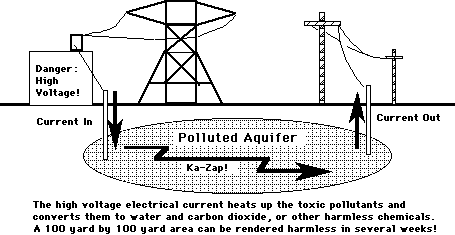Electrification
Electrification is a new way to clean up pollution in aquifers
by placing high voltage electrodes into the aquifer (via a well) in two places
about one hundred yards apart. Turning on the electricity sends the electric
spark through the water in the aquifer. The high energy of the electricity
heats any organic molecules, including pollutants and converts them to safer
materials, such as water and air.

Cost: $8 million/ or about $175 extra
on the tax bill for 10 years.
Pros
1. One of the least expensive cleanup methods ().
2. Nothing needs to be dug up. No buildings need to be destroyed.
3. This method will clean up a 100 yard by 100 yard area in
about a week.
4. Relatively safe method--Ways can be devised to prevent electric
shock from the ground.
Cons
1. Test only in the lab, not in the real world.
2. It may be hard to control where the electric field goes.
3. Long term exposure to electric fields may cause cancer and
birth defects.
4. Chance of electrocution.
5. Small amounts of pollution might still be left behind.
Links:
